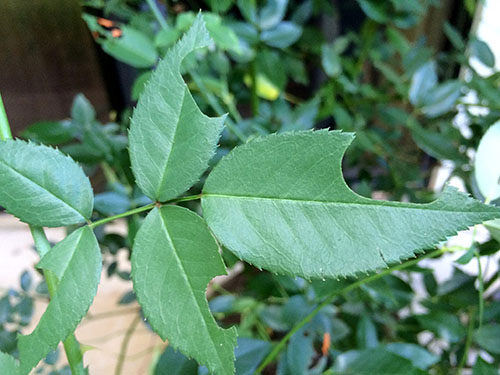
Leafcutter bees (Megachile spp.) are solitary native bees. There are many different species of leafcutter bees with over a thousand species worldwide. In North America, there are around 140 native species of leafcutter bees. Unfortunately, I can’t find a good resource for how many of those are found in Kentucky or the surrounding states.
Most of our leafcutter bees are about the size of a honey bee. One way to identify leafcutter bees compared to other types of bees is by looking at where they store pollen. Leafcutter bees don’t store pollen on their legs. Instead, leafcutter bees store pollen in the stiff hairs located on the underside of their abdomens. Leafcutter bees also have a very pointed rear end and sometimes have a tendency to arch their backs. Like honey bees, leafcutter bees are important pollinators.
As you might imagine, the common name of “leafcutter bee” is descriptive of their behavior. If you’ve ever seen a plant that looks like someone took a hole punch to the sides of the leaves, then you’ve seen the work of a leafcutter bee. While this can make the plants look funny, it doesn’t harm the plants. The damage is completely cosmetic and should be tolerated in return for the important pollination benefits the bees provide.
Female leafcutter bees use their large jaws to cut quarter- to half-inch circles or ovals out of the sides of leaves. The cuts can be very smooth and are almost always on the sides of the leaves. After cutting a circle or oval patch of leaf, the female leafcutter bee carries the leaf as she flies to her nesting site.

As a solitary bee, each female leafcutter bee will have her own nest. However, many leafcutter bees will often nest in close proximity to each other, like a tightly packed bee subdivision. Leafcutter bees nest in abandoned beetle tunnels, hollow plant stems, small crevices in rocks, and similar types of locations. They are one of the many types of bees that will use a mason bee house.
The female leafcutter bee uses the pieces of leaves that she harvests to line her nesting tunnel and create individual rooms for her eggs. (The Toronto Zoo has a great video on YouTube of a leafcutter bee building her nesting tunnel.) The leafcutter bee starts at the back of the tunnel and lines the back, roof, floor, and sides with leaf pieces. She’ll also create leafy walls to divide the tunnel into multiple sections. The leafy tubes created by leafcutter bees are often described as looking like cigars.
A female leafcutter bee will stock each section of her nesting tube with a mixture of pollen and nectar before she lays an egg in the section, seals up the section with the leafy wall, and repeats the process in the next section. Once the egg hatches, the larva will eat the nectar and pollen that Mom stored for it. It will go through several larval stages before pupating and eventually metamorphosing into an adult bee. The adult bees will emerge from their leafy tunnels the following spring and begin the cycle over again. Each adult bee only lives for a month or two.
Leafcutter bees are a great native bee to encourage to nest in your yard or garden. To encourage them to nest in your yard, try putting out a bee hotel or mason bee house. Then make sure you have lots of different types of flowering plants available throughout the season that they can use to collect pollen and nectar. Leafcutter bees only fly a few hundred feet from their nesting site, so it is important to make sure they have all the resources they need in close proximity. Probably most importantly, don’t freak out if some of the leaves on your plants begin to have smooth holes cut out of the edges. That’s just evidence that you are doing a good job and have a very healthy leafcutter bee population.


This article was part of Shannon’s original Kentucky Pollinators and Backyard Wildlife blog which evolved into the blog for Backyard Ecology.

Backyard Ecology: Exploring Nature in Your Backyard
Nature isn’t just “out there.” It’s all around us, including right outside our doors. Hi, my name is Shannon Trimboli, and I am the host of Backyard Ecology. I live in southcentral Kentucky and am a wildlife biologist, educator, author, beekeeper, and owner of a nursery specializing in plants for pollinators and wildlife conservation. I invite you to join me as we ignite our curiosity and natural wonder, explore our yards and communities, and improve our local pollinator and wildlife habitat. Learn more or subscribe to my email list at www.backyardecology.net.

Leave a Reply